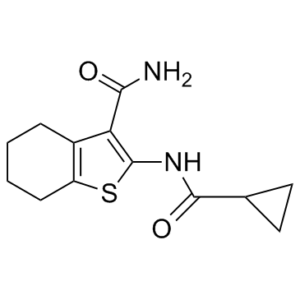AX20017 is a highly selective low-molecular-weight inhibitor of protein kinase G (PknG) with an IC50 of 0.39 μM. The pathogenicity of mycobacteria such as Mycobacterium tuberculosis is closely associated with their capacity to survive within host macrophages. A crucial virulence factor for intracellular mycobacterial survival is protein kinase G (PknG), a eukaryotic-like serine/threonine protein kinase expressed by pathogenic mycobacteria that blocks the intracellular degradation of mycobacteria in lysosomes. In the 2.4 A x-ray crystal structure of PknG in complex with AX20017, the compound AX20017 is bound deep within a narrow pocket formed by the inter lobe cleft of the PknG domain. The structure of PknG-AX20017 further reveals that the inhibitor is buried deep within the adenosine-binding site, targeting an active conformation of the kinase domain. Remarkably, although the topology of the kinase domain is reminiscent of eukaryotic kinases, the AX20017-binding pocket is shaped by a unique set of amino acid side chains that are not found in any human kinase. Directed mutagenesis of the unique set of residues resulted in a drastic loss of the compound's inhibitory potency.The results explain the specific mode of action of AX20017 and demonstrate that virulence factors highly homologous to host molecules can be successfully targeted to block the proliferation of M. tuberculosis.
Physicochemical Properties
| Molecular Formula | C₁₃H₁₆N₂O₂S | |
| Molecular Weight | 264.34 | |
| Exact Mass | 268.12 | |
| Elemental Analysis | C, 58.18; H, 7.51; N, 10.44; O, 11.92; S, 11.95 | |
| CAS # | 329221-38-7 | |
| Related CAS # |
|
|
| PubChem CID | 673481 | |
| Appearance | Solid powder | |
| LogP | 3.235 | |
| Hydrogen Bond Donor Count | 2 | |
| Hydrogen Bond Acceptor Count | 3 | |
| Rotatable Bond Count | 3 | |
| Heavy Atom Count | 18 | |
| Complexity | 370 | |
| Defined Atom Stereocenter Count | 0 | |
| SMILES | S1C(=C(C(N([H])[H])=O)C2=C1C([H])([H])C([H])([H])C([H])([H])C2([H])[H])N([H])C(C1([H])C([H])([H])C1([H])[H])=O |
|
| InChi Key | IEETZPYULYBOCV-UHFFFAOYSA-N | |
| InChi Code | InChI=1S/C13H20N2O2S/c14-11(16)10-8-3-1-2-4-9(8)18-13(10)15-12(17)7-5-6-7/h7-10,13H,1-6H2,(H2,14,16)(H,15,17) | |
| Chemical Name | 2-(Cyclopropanecarbonylamino)-2,3,3a,4,5,6,7,7a-octahydro-1-benzothiophene-3-carboxamide | |
| Synonyms |
|
|
| HS Tariff Code | 2934.99.03.00 | |
| Storage |
Powder-20°C 3 years 4°C 2 years In solvent -80°C 6 months -20°C 1 month |
|
| Shipping Condition | Room temperature (This product is stable at ambient temperature for a few days during ordinary shipping and time spent in Customs) |
Biological Activity
| ln Vitro |
|
||
| ln Vivo |
|
||
| Animal Protocol |
|
||
| References | Bioinformation.2011;7(1):1-4. Epub 2011 Aug 20.Proc Natl Acad Sci U S A.2007 Jul 17;104(29):12151-6. Epub 2007 Jul 6. |
Solubility Data
| Solubility (In Vitro) |
DMSO : 53~130 mg/mL ( 200.49~491.79 mM ) Ethanol : ~3 mg/mL |
| Solubility (In Vivo) |
Solubility in Formulation 1: ≥ 3.25 mg/mL (12.29 mM) (saturation unknown) in 10% DMSO + 90% Corn Oil (add these co-solvents sequentially from left to right, and one by one), clear solution. For example, if 1 mL of working solution is to be prepared, you can add 100 μL of 32.5 mg/mL clear DMSO stock solution to 900 μL of corn oil and mix evenly. Solubility in Formulation 2: 10% DMSO+90% Corn Oil: ≥ 3.25 mg/mL (12.29 mM) (Please use freshly prepared in vivo formulations for optimal results.) |
| Preparing Stock Solutions | 1 mg | 5 mg | 10 mg | |
| 1 mM | 3.7830 mL | 18.9150 mL | 37.8301 mL | |
| 5 mM | 0.7566 mL | 3.7830 mL | 7.5660 mL | |
| 10 mM | 0.3783 mL | 1.8915 mL | 3.7830 mL |
